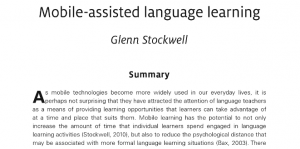As I had never heard of Mobile Assisted Language Learning prior to taking this class, I am very interested in exploring it. If readers are interested in a good overview of this topic, Stockwell’s (2012) article is a good starting point (full source at end of blog post).
 I think that like any other technology, MALL has potential benefits and drawbacks, and teachers should take care not to use it just because they can. As Stockwell points out on the page pictured at left, other researchers have noted that using a mobile device has two major potential advantages: (1) that learners have more access to these kinds of devices and thus might spend more time on language-related tasks and (2) that using a very personal, everyday device can shrink the distance between language learners and their targets by bringing the instruction literally to their fingertips.
I think that like any other technology, MALL has potential benefits and drawbacks, and teachers should take care not to use it just because they can. As Stockwell points out on the page pictured at left, other researchers have noted that using a mobile device has two major potential advantages: (1) that learners have more access to these kinds of devices and thus might spend more time on language-related tasks and (2) that using a very personal, everyday device can shrink the distance between language learners and their targets by bringing the instruction literally to their fingertips.
When I first encountered this term, my immediate reaction was to consider how this would affect classroom management. Would students be even more obsessed with their phones? Would instructors be able to differentiate on- vs. off-task behaviors? But I guess the true question to ask is whether or not the mobile device can function as a good source of input and provide relevant, useful practice for students? Of course we can’t answer that question unless we pose it in a particular scenario with specific learners in a given context, but we can imagine that, if used effectively with good software in conjunction with a good curriculum, it might be a wonderful addition.
At this point, I think I am still wary about the use of MALL as part of a syllabus as required work. After working with adult language learners for so long, I know that this would be a deterrent for many of my former students. And it’s worth pointing out that unless the device is provided by the institution such that all students are working on the same hardware/software/apps, then it creates a nightmare for a teacher trying to help students troubleshoot any problems that might come up.
However, on its own as a stand alone supplemental way to enhance one’s personal adventures in language learning, I think it has major potential. In fact, I think the personal nature of a mobile device is the key to getting MALL moving in the right direction. People expect their mobile devices to be customized to their preferences. If a language learning app or program cannot rise to that occasion, then in my opinion, it’s not worth it. There are too many other ways to accomplish the same goal. So, to the extent that MALL can be customized and personalized, I feel it could hold a lot of potential for supplemental language learning.
Source:
Stockwell, G. (2012). Mobile-assisted language learning. Contemporary computer-assisted language learning, 16(3), 24-31.
It’s unfortunate that such a powerful and ubiquitous technology as mobile devices has become such a bane to education, when it seems like it has so many potential affordances. With the effort we put toward getting students to put their devices away, it does seem like a Pandora’s box to ask them to use their mobile devices for class.
Meanwhile, I think it is worth considering that the mobile device is also the student’s property, a representation of their personal space, and that it is private to them. In what ways might instructors be encroaching on their students’ liberties by asking them to install an app for language learning? Is it fair to tell them to welcome that intrusion? Compared to a notebook that a student might use to store class notes, or even a blog, a mobile device is personal in a way that most technology is not. So when we think about implementing MALL in classrooms, we also need to consider how we might be insinuating our presence into the students’ personal spaces.
Had not even thought of personal space! Great addition to this discussion.